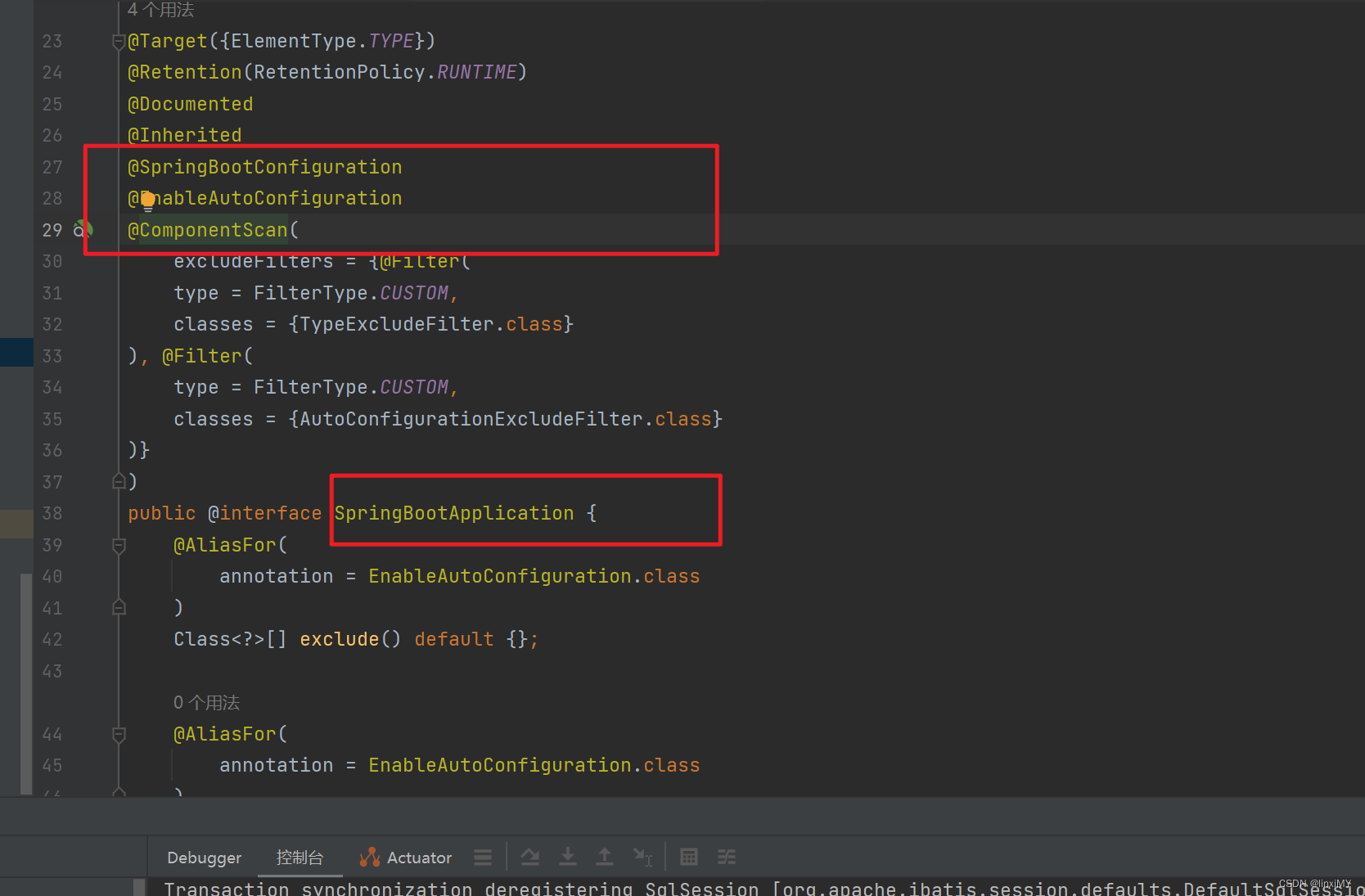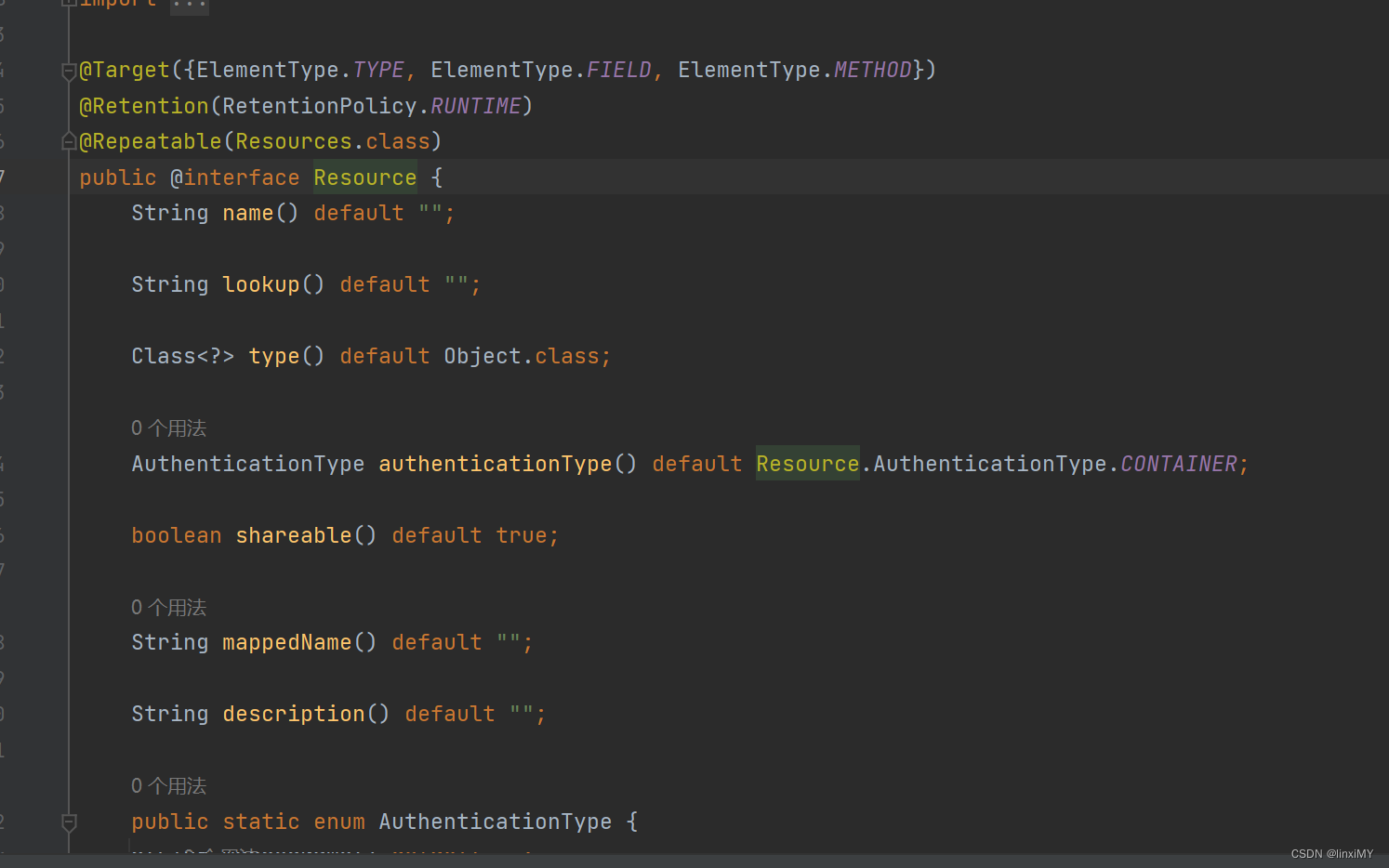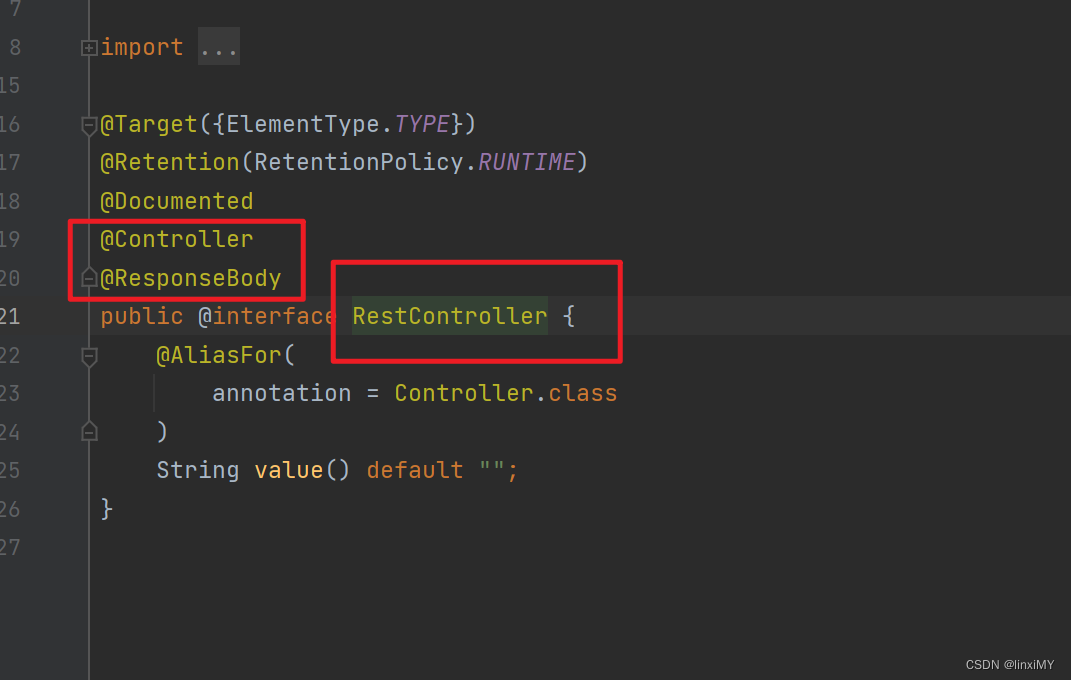一篇文章带你了解Spring/SpringBoot常用注解(建议收藏!!! )

这篇文章介绍的 Spring/SpringBoot 常用注解基本已经涵盖你工作中遇到的大部分常用的场景。对于每一个注解我都说了具体用法,掌握搞懂,使用 SpringBoot 来开发项目基本没啥大问题了!
1. @SpringBootApplication
这里先单独拎出@SpringBootApplication 注解说一下,虽然我们一般不会主动去使用它。
@SpringBootApplication
public class SpringSecurityJwtGuideApplication {public static void main(java.lang.String[] args) {SpringApplication.run(SpringSecurityJwtGuideApplication.class, args);}
}常问的面试题:
我们可以把 @SpringBootApplication看作是 @Configuration、@EnableAutoConfiguration、@ComponentScan 注解的集合。
package org.springframework.boot.autoconfigure;
@Target(ElementType.TYPE)
@Retention(RetentionPolicy.RUNTIME)
@Documented
@Inherited
@SpringBootConfiguration
@EnableAutoConfiguration
@ComponentScan(excludeFilters = {@Filter(type = FilterType.CUSTOM, classes = TypeExcludeFilter.class),@Filter(type = FilterType.CUSTOM, classes = AutoConfigurationExcludeFilter.class) })
public @interface SpringBootApplication {......
}package org.springframework.boot;
@Target(ElementType.TYPE)
@Retention(RetentionPolicy.RUNTIME)
@Documented
@Configuration
public @interface SpringBootConfiguration {} 
根据 SpringBoot 官网,这三个注解的作用分别是:
-
@EnableAutoConfiguration:启用 SpringBoot 的自动配置机制 -
@ComponentScan: 扫描被@Component(@Service,@Controller)注解的 bean,注解默认会扫描该类所在的包下所有的类。 -
@Configuration:允许在 Spring 上下文中注册额外的 bean 或导入其他配置类
2. Spring Bean 相关
2.1. @Autowired
自动导入对象到类中,被注入进的类同样要被 Spring 容器管理比如:Service 类注入到 Controller 类中。
@RestController
@RequestMapping("/users")
public class UserController {@Autowiredprivate UserService userService;......
}
2.2. @Resource
@Resource 都可以用来在 Spring 中自动装配 bean
@RestController
@RequestMapping("/users")
public class UserController {@Resourceprivate UserService userService;......
}
@Autowired 和 @Resource 都可以用来在 Spring 中自动装配 bean,但它们之间有一些重要的区别:
1:@Autowired 是 Spring 框架中自带的注解,用来实现自动装配。它可以用在属性、构造器、方法上,默认按类型匹配,当然也可以通过 @Qualifier 来指定某个具体的 bean。
2:@Resource 是 Java 标准库中自带的注解,用来实现自动装配。它只能用在属性上,默认按照名称匹配,如果没有找到名称匹配的 bean,则按类型匹配。
2.3. Component,@Repository,@Service, @Controller
我们一般使用 @Autowired 注解让 Spring 容器帮我们自动装配 bean。要想把类标识成可用于 @Autowired 注解自动装配的 bean 的类,可以采用以下注解实现:
-
@Component:通用的注解,可标注任意类为Spring组件。如果一个 Bean 不知道属于哪个层,可以使用@Component注解标注。 -
@Repository: 对应持久层即 Dao 层,主要用于数据库相关操作。 -
@Service: 对应服务层,主要涉及一些复杂的逻辑,需要用到 Dao 层。 -
@Controller: 对应 Spring MVC 控制层,主要用户接受用户请求并调用 Service 层返回数据给前端页面。
2.4. @RestController
@RestController注解是@Controller和@ResponseBody的合集,表示这是个控制器 bean,并且是将函数的返回值直 接填入 HTTP 响应体中,是 REST 风格的控制器

单独使用 @Controller 不加 @ResponseBody的话一般使用在要返回一个视图的情况,这种情况属于比较传统的 Spring MVC 的应用,对应于前后端不分离的情况。@Controller +@ResponseBody 返回 JSON 或 XML 形式数据
2.5. @Scope
声明 Spring Bean 的作用域,使用方法:
@Bean
@Scope("singleton")
public Person personSingleton() {return new Person();
}四种常见的 Spring Bean 的作用域:
-
singleton : 唯一 bean 实例,Spring 中的 bean 默认都是单例的。
-
prototype : 每次请求都会创建一个新的 bean 实例。
-
request : 每一次 HTTP 请求都会产生一个新的 bean,该 bean 仅在当前 HTTP request 内有效。
-
session : 每一次 HTTP 请求都会产生一个新的 bean,该 bean 仅在当前 HTTP session 内有效。
2.6. Configuration
一般用来声明配置类,可以使用 @Component注解替代,不过使用Configuration注解声明配置类更加语义化。
@Configuration
public class AppConfig {@Beanpublic TransferService transferService() {return new TransferServiceImpl();}}3. 处理常见的 HTTP 请求类型
5 种常见的请求类型:
-
GET :请求从服务器获取特定资源。举个例子:
GET /users(获取所有学生) -
POST :在服务器上创建一个新的资源。举个例子:
POST /users(创建学生) -
PUT :更新服务器上的资源(客户端提供更新后的整个资源)。举个例子:
PUT /users/12(更新编号为 12 的学生) -
DELETE :从服务器删除特定的资源。举个例子:
DELETE /users/12(删除编号为 12 的学生) -
PATCH :更新服务器上的资源(客户端提供更改的属性,可以看做作是部分更新),使用的比较少,这里就不举例子了。
3.1. GET 请求 (多)
@GetMapping("users") 等价于@RequestMapping(value="/users",method=RequestMethod.GET)
@GetMapping("/users")
或者:@RequestMapping(value="/users",method=RequestMethod.GET)
public ResponseEntity<List<User>> getAllUsers() {return userRepository.findAll();
}3.2. POST 请求(多)
@PostMapping("users") 等价于@RequestMapping(value="/users",method=RequestMethod.POST)
关于@RequestBody注解的使用,在下面的“前后端传值”这块会讲到。
@PostMapping("/users")
public ResponseEntity<User> createUser(@Valid @RequestBody User user)return userRespository.save(user);
}3.3. PUT 请求(少,基本不用)
@PutMapping("/users/{userId}") 等价于@RequestMapping(value="/users/{userId}",method=RequestMethod.PUT)
@PutMapping("/users/{userId}")
public ResponseEntity<User> updateUser(@PathVariable(value = "userId") Long userId,@Valid @RequestBody UserUpdateRequest userUpdateRequest) {......
}3.4. DELETE 请求(少,基本不用)
@DeleteMapping("/users/{userId}")等价于@RequestMapping(value="/users/{userId}",method=RequestMethod.DELETE)
@DeleteMapping("/users/{userId}")
public ResponseEntity deleteUser(@PathVariable(value = "userId") Long userId){......
}3.5. PATCH 请求(基本不用)
一般实际项目中,我们都是 PUT 不够用了之后才用 PATCH 请求去更新数据。
@PatchMapping("/profile")public ResponseEntity updateStudent(@RequestBody StudentUpdateRequest studentUpdateRequest) {studentRepository.updateDetail(studentUpdateRequest);return ResponseEntity.ok().build();}4. 前后端传值
掌握前后端传值的正确姿势,是你开始 CRUD 的第一步!
4.1. @PathVariable 和 @RequestParam
@PathVariable用于获取路径参数(适用于RestFul风格),@RequestParam(适用与GET请求,POST请求)用于获取查询参数。
举个简单的例子:
@GetMapping("/klasses/{klassId}/teachers")
public List<Teacher> getKlassRelatedTeachers(@PathVariable("klassId") Long klassId,@RequestParam(value = "type", required = false) String type ) {
...
}如果我们请求的 url 是:/klasses/{123456}/teachers?type=web
那么我们服务获取到的数据就是:klassId=123456,type=web。
4.2. @RequestBody(一般常用于Post请求)
@RequestBody 注解用于将请求正文中的数据绑定到方法参数上,常用于处理 Content-Type 为 "application/json" 或 "application/xml" 类型的请求。
例子:
@PostMapping("/sign-up")
public ResponseEntity signUp(@RequestBody @Valid UserRegisterRequest userRegisterRequest) {userService.save(userRegisterRequest);return ResponseEntity.ok().build();
}UserRegisterRequest对象:
@Data
@AllArgsConstructor
@NoArgsConstructor
public class UserRegisterRequest {@NotBlankprivate String userName;@NotBlankprivate String password;@FullName@NotBlankprivate String fullName;
}我们发送 post 请求到这个接口,并且 body 携带 JSON 数据:
{"userName":"coder","fullName":"shuangkou","password":"123456"} 需要注意的是:一个请求方法只可以有一个@RequestBody,但是可以有多个@RequestParam和@PathVariable。 如果你的方法必须要用两个 @RequestBody来接受数据的话,大概率是你的数据库设计或者系统设计出问题了!(会报错的!!!!)
5. 读取配置信息
很多时候我们需要将一些常用的配置信息比如阿里云 oss、发送短信、微信认证的相关配置信息等等放到配置文件中。
下面我们来看一下 Spring 为我们提供了哪些方式帮助我们从配置文件中读取这些配置信息。
我们的数据源application.yml内容如下:
wuhan2020: 但是,我相信一切都会过去!武汉加油!中国加油!my-profile:name: Guide哥email: koushuangbwcx@163.comlibrary:location: 湖北武汉加油中国加油books:- name: 天才基本法description: 二十二岁的林朝夕在父亲确诊阿尔茨海默病这天,得知自己暗恋多年的校园男神裴之即将出国深造的消息——对方考取的学校,恰是父亲当年为她放弃的那所。- name: 时间的秩序description: 为什么我们记得过去,而非未来?时间“流逝”意味着什么?是我们存在于时间之内,还是时间存在于我们之中?卡洛·罗韦利用诗意的文字,邀请我们思考这一亘古难题——时间的本质。- name: 了不起的我description: 如何养成一个新5.1. @value(常用)
使用 @Value("${property}") 读取比较简单的配置信息:
@Value("${wuhan2020}")
String wuhan2020;5.2. @ConfigurationProperties(常用)
通过@ConfigurationProperties读取配置信息并与 bean 绑定。
@Component
@ConfigurationProperties(prefix = "library")
class LibraryProperties {@NotEmptyprivate String location;private List<Book> books;@Setter@Getter@ToStringstatic class Book {String name;String description;}省略getter/setter......
}5.3. PropertySource(不常用)
@PropertySource读取指定 properties 文件
@Component
@PropertySource("classpath:website.properties")class WebSite {@Value("${url}")private String url;省略getter/setter......
}6. 参数校验
数据的校验的重要性就不用说了,即使在前端对数据进行校验的情况下,我们还是要对传入后端的数据再进行一遍校验,避免用户绕过浏览器直接通过一些 HTTP 工具直接向后端请求一些违法数据。
JSR(Java Specification Requests) 是一套 JavaBean 参数校验的标准,它定义了很多常用的校验注解,我们可以直接将这些注解加在我们 JavaBean 的属性上面,这样就可以在需要校验的时候进行校验了,非常方便!
校验的时候我们实际用的是 Hibernate Validator 框架。Hibernate Validator 是 Hibernate 团队最初的数据校验框架,Hibernate Validator 4.x 是 Bean Validation 1.0(JSR 303)的参考实现,Hibernate Validator 5.x 是 Bean Validation 1.1(JSR 349)的参考实现,目前最新版的 Hibernate Validator 6.x 是 Bean Validation 2.0(JSR 380)的参考实现。
SpringBoot 项目的 spring-boot-starter-web 依赖中已经有 hibernate-validator 包,不需要引用相关依赖。如下图所示(通过 idea 插件—Maven Helper 生成):
6.1. 一些常用的字段验证的注解
-
@NotEmpty被注释的字符串的不能为 null 也不能为空 -
@NotBlank被注释的字符串非 null,并且必须包含一个非空白字符 -
@Null被注释的元素必须为 null -
@NotNull被注释的元素必须不为 null -
@AssertTrue被注释的元素必须为 true -
@AssertFalse被注释的元素必须为 false -
@Pattern(regex=,flag=)被注释的元素必须符合指定的正则表达式 -
@Email被注释的元素必须是 Email 格式。 -
@Min(value)被注释的元素必须是一个数字,其值必须大于等于指定的最小值 -
@Max(value)被注释的元素必须是一个数字,其值必须小于等于指定的最大值 -
@DecimalMin(value)被注释的元素必须是一个数字,其值必须大于等于指定的最小值 -
@DecimalMax(value)被注释的元素必须是一个数字,其值必须小于等于指定的最大值 -
@Size(max=, min=)被注释的元素的大小必须在指定的范围内 -
@Digits (integer, fraction)被注释的元素必须是一个数字,其值必须在可接受的范围内 -
@Past被注释的元素必须是一个过去的日期 -
@Future被注释的元素必须是一个将来的日期 - 详情可以看我这篇文章:
- Spring中@NotEmpty、@NotBlank、@NotNull 区别和使用_linxiMY的博客-CSDN博客适用于基本数据类型(Integer,Long,Double等等),当 @NotNull 注解被使用在 String 类型的数据上,则表示该数据不能为 Null(但是可以为 Empty)注:被其标注的字段可以使用 @size、@Max、@Min 对字段数值进行大小的控制适用于 String 类型的数据上,加了@NotBlank 注解的参数不能为 Null 且 trim() 之后 size > 0,必须有实际字符@NotEmpty。
https://blog.csdn.net/XikYu/article/details/128869563?ops_request_misc=%257B%2522request%255Fid%2522%253A%2522168204468216800226568490%2522%252C%2522scm%2522%253A%252220140713.130102334.pc%255Fblog.%2522%257D&request_id=168204468216800226568490&biz_id=0&utm_medium=distribute.pc_search_result.none-task-blog-2~blog~first_rank_ecpm_v1~rank_v31_ecpm-6-128869563-null-null.blog_rank_default&utm_term=%E5%8F%82%E6%95%B0&spm=1018.2226.3001.4450
6.2. 验证请求体(RequestBody)
@Data
@AllArgsConstructor
@NoArgsConstructor
public class Person {@NotNull(message = "classId 不能为空")private String classId;@Size(max = 33)@NotNull(message = "name 不能为空")private String name;@Pattern(regexp = "((^Man$|^Woman$|^UGM$))", message = "sex 值不在可选范围")@NotNull(message = "sex 不能为空")private String sex;@Email(message = "email 格式不正确")@NotNull(message = "email 不能为空")private String email;}我们在需要验证的参数上加上了@Valid注解或者@Validated(实体类上添加啊注解,controller类接收参数时使用上@Valid注解或者@Validated ,,,,,,必须同时使用才能生效),如果验证失败,它将抛出MethodArgumentNotValidException。
@RestController
@RequestMapping("/api")
public class PersonController {@PostMapping("/person")public ResponseEntity<Person> getPerson(@RequestBody @Valid Person person) {return ResponseEntity.ok().body(person);}
}6.3. 验证请求参数(Path Variables 和 Request Parameters)
@RestController
@RequestMapping("/api")
@Validated
public class PersonController {@GetMapping("/person/{id}")public ResponseEntity<Integer> getPersonByID(@Valid @PathVariable("id") @Max(value = 5,message = "超过 id 的范围了") Integer id) {return ResponseEntity.ok().body(id);}
}7. 全局处理 Controller 层异常
介绍一下我们 Spring 项目必备的全局处理 Controller 层异常。
相关注解:
-
@ControllerAdvice:注解定义全局异常处理类 -
@ExceptionHandler:注解声明异常处理方法
如何使用呢?拿我们在第 5 节参数校验这块来举例子。如果方法参数不对的话就会抛出MethodArgumentNotValidException,我们来处理这个异常。
示例:
@ControllerAdvice
@ResponseBody
public class GlobalExceptionHandler {/* 请求参数异常处理*/@ExceptionHandler(MethodArgumentNotValidException.class)public ResponseEntity<?> handleMethodArgumentNotValidException(MethodArgumentNotValidException ex, HttpServletRequest request) {......}
}例子:
@RestControllerAdvice
@Slf4j
public class ExceptionControllerAdvice {@ExceptionHandler(value = MethodArgumentNotValidException.class)public Result handleValidException(MethodArgumentNotValidException e) {log.error("数据校验出现问题{},异常类型{}", e.getMessage(), e.getClass());BindingResult bindingResult = e.getBindingResult();HashMap<String, Object> errorMap = new HashMap<>();bindingResult.getFieldErrors().forEach(item->{System.out.println(item);errorMap.put(item.getField(), item.getDefaultMessage());});return Result.fail(404,String.valueOf(errorMap));}
}8. 事务 @Transactional
在要开启事务的方法上使用@Transactional注解即可!
可以放在类上,也可放在方法中:
@Transactional(rollbackFor = Exception.class)我们知道 Exception 分为运行时异常 RuntimeException 和非运行时异常。在@Transactional注解中如果不配置rollbackFor属性,那么事物只会在遇到RuntimeException的时候才会回滚,加上rollbackFor=Exception.class,可以让事物在遇到非运行时异常时也回滚。
@Transactional 注解一般用在可以作用在 类 或者 方法 上。
-
作用于类:当把
@Transactional 注解放在类上时,表示所有该类的public 方法都配置相同的事务属性信息。 -
作用于方法:当类配置了
@Transactional,方法也配置了@Transactional,方法的事务会覆盖类的事务配置信息。

9. json 数据处理
10.1. 过滤 json 数据
@JsonIgnoreProperties 作用在类上用于过滤掉特定字段不返回或者不解析。
//生成json时将userRoles属性过滤
@JsonIgnoreProperties({"userRoles"})
public class User {private String userName;private String fullName;private String password;@JsonIgnoreprivate List<UserRole> userRoles = new ArrayList<>();
}@JsonIgnore一般用于类的属性上,作用和上面的@JsonIgnoreProperties 一样。
public class User {private String userName;private String fullName;private String password;//生成json时将userRoles属性过滤@JsonIgnoreprivate List<UserRole> userRoles = new ArrayList<>();
}10.2. 格式化 json 数据
@JsonFormat一般用来格式化 json 数据。:
比如:
@JsonFormat(shape=JsonFormat.Shape.STRING, pattern="yyyy-MM-dd'T'HH:mm:ss.SSS'Z'", timezone="GMT")
private Date date;@ApiModelProperty("打卡时间")
@JsonFormat(pattern = "yyyy-MM-dd", timezone = "GMT+8")
private Date dakaTime;
10.3. 扁平化对象
@Getter
@Setter
@ToString
public class Account {@JsonUnwrappedprivate Location location;@JsonUnwrappedprivate PersonInfo personInfo;@Getter@Setter@ToStringpublic static class Location {private String provinceName;private String countyName;}@Getter@Setter@ToStringpublic static class PersonInfo {private String userName;private String fullName;}
}
未扁平化之前:
{"location": {"provinceName":"湖北","countyName":"武汉"},"personInfo": {"userName": "coder1234","fullName": "shaungkou"}
}使用@JsonUnwrapped 扁平对象之后:
@Getter
@Setter
@ToString
public class Account {@JsonUnwrappedprivate Location location;@JsonUnwrappedprivate PersonInfo personInfo;......
}
{"provinceName":"湖北","countyName":"武汉","userName": "coder1234","fullName": "shaungkou"
}11. 测试相关
@ActiveProfiles一般作用于测试类上, 用于声明生效的 Spring 配置文件。
@SpringBootTest(webEnvironment = RANDOM_PORT)
@ActiveProfiles("test")
@Slf4j
public abstract class TestBase {......
}@Test声明一个方法为测试方法
@Transactional被声明的测试方法的数据会回滚,避免污染测试数据。
@WithMockUser Spring Security 提供的,用来模拟一个真实用户,并且可以赋予权限。
@Test@Transactional@WithMockUser(username = "user-id-18163138155", authorities = "ROLE_TEACHER")void should_import_student_success() throws Exception {......}12:自定义注解(可以通过redis实现,也可以通过切面实现)
下面是一个示例:
@RepeatSubmit
package com.shijiu.annotation;
import java.lang.annotation.*;/* @Author * @Date Created in 2023/4/11 11:36* @DESCRIPTION: 自定义注解解决重复提交接口* @Version V1.0*/
@Inherited
@Target(ElementType.METHOD)
@Retention(RetentionPolicy.RUNTIME)
@Documented
public @interface RepeatSubmit
{/* 间隔时间(ms),小于此时间视为重复提交*/public int interval() default 1000;/* 提示消息*/public String message() default "不允许重复提交,请稍候再试";
}
切面类:RepeatSubmitAspect.java
package com.shijiu.aop;import com.shijiu.annotation.RepeatSubmit;
import com.shijiu.vo.Result;
import org.aspectj.lang.ProceedingJoinPoint;
import org.aspectj.lang.annotation.Around;
import org.aspectj.lang.annotation.Aspect;
import org.aspectj.lang.reflect.MethodSignature;
import org.springframework.stereotype.Component;import java.lang.reflect.Method;
import java.util.Arrays;
import java.util.Map;
import java.util.concurrent.ConcurrentHashMap;/* @Author * @Date Created in 2023/4/11 11:40* @DESCRIPTION: 限制 一段时间可以请求的次数* @Version V1.0*/
@Aspect
@Component
public class RepeatSubmitAspect {private static final Map<String, Long> REQUEST_TIME_MAP = new ConcurrentHashMap<>();@Around("@annotation(repeatSubmit)")public Object around(ProceedingJoinPoint point, RepeatSubmit repeatSubmit) throws Throwable {Object result = null;MethodSignature signature = (MethodSignature) point.getSignature();Method method = signature.getMethod();String key = method.getName() + ":" + Arrays.toString(point.getArgs());Long requestTime = REQUEST_TIME_MAP.get(key);long currentTime = System.currentTimeMillis();if (requestTime == null || currentTime - requestTime >= repeatSubmit.interval()) {result = point.proceed();REQUEST_TIME_MAP.put(key, currentTime);} else {return Result.fail(201,repeatSubmit.message());}return result;}
}
效果图:

补充:
13、Spring Cloud
1、@EnableEurekaServer
用在springboot启动类上,表示这是一个eureka服务注册中心;
2、@EnableDiscoveryClient
用在springboot启动类上,表示这是一个服务,可以被注册中心找到;
3、@LoadBalanced
开启负载均衡能力;
4、@EnableCircuitBreaker
用在启动类上,开启断路器功能;
5、@HystrixCommand(fallbackMethod=”backMethod”)
用在方法上,fallbackMethod指定断路回调方法;
6、@EnableConfigServer
用在启动类上,表示这是一个配置中心,开启Config Server;
7、@EnableZuulProxy
开启zuul路由,用在启动类上;
8、@SpringCloudApplication
@SpringBootApplication
@EnableDiscovertyClient
@EnableCircuitBreaker
分别是SpringBoot注解、注册服务中心Eureka注解、断路器注解。对于SpringCloud来说,这是每一微服务必须应有的三个注解,所以才推出了@SpringCloudApplication这一注解集合。
等。。。。。。。。。。。。。。。。。。。


